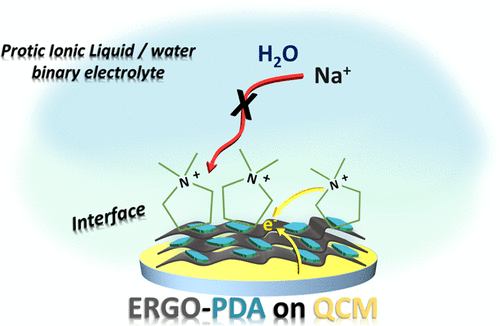Highly Ordered Graphene Polydopamine Composite Allowing Fast Motion of Cations: Toward a High-Performance Microsupercapacitor
Authors: Adnane Bouzina, René Meng, Cyrille Bazin, Hubert Perrot, Ozlem Sel, Catherine Debiemme-Chouvy
Journal: Adv. Mater. Interfaces (2023)
Abstract
The simple and eco-friendly preparation of microsupercapacitor remains a great challenge. Here are presented the preparation and the characterizations of an all-solid symmetric micro-supercapacitor based on a new composite formed of highly ordered graphene sheets due to the presence of polydopamine between the layers, which present a d-spacing of 0.356 nm. This graphene-polydopamine composite is prepared by electroreduction of graphene oxide (GO) followed by the electrooxidation of dopamine added into the initial solution, i.e., after GO reduction. In Na2SO4 solution, this composite material shows excellent capacitance and stability even at a high scan rate (2 V s−1) and a very low relaxation time (τ0) of 62 ms. This value is in very good agreement with the high transfer kinetic and low transfer resistance values of the ions implied in the charge storage process (Na+·2H2O and Na+) determined by ac-electrogravimetry. Finally, it is shown that the all-solid micro-supercapacitor (interdigitated electrodes obtained using a CO2 laser and Na2SO4/PVA hydrogel) prepared with this new composite delivers a remarkable energy density of 6.36 mWh cm−3 for a power density of 0.22 W cm−3 and exhibits excellent cycling stability (98% of retention after 10 000 cycles at 2 V s−1).
You may read the full paper here.
Highly Ordered Graphene Polydopamine Composite Allowing Fast Motion of Cations: Toward a High-Performance Microsupercapacitor




